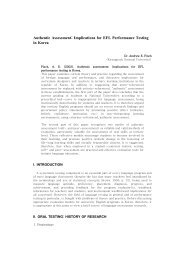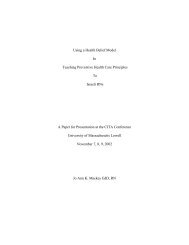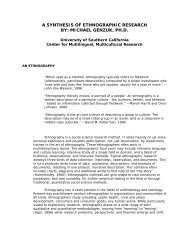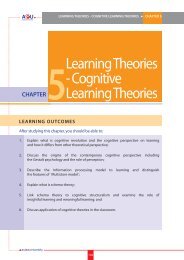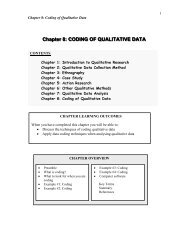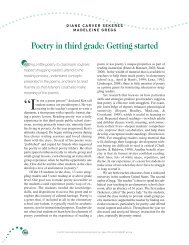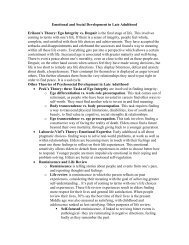Learning Theories - Cognitive Learning Theories CHAPTER
Learning Theories - Cognitive Learning Theories CHAPTER
Learning Theories - Cognitive Learning Theories CHAPTER
You also want an ePaper? Increase the reach of your titles
YUMPU automatically turns print PDFs into web optimized ePapers that Google loves.
<strong>CHAPTER</strong> 5 l LEARNING THEORIES - COGNITIVE LEARNING THEORIES<br />
i) The Law of Good form or Pragnanz<br />
The word ‘Gestalt’ means ‘form’ or ‘shape’. Gestalt psychologists were of the view<br />
that psychological organization will always be as ‘good’ as prevailing conditions allow. For<br />
Gestalt psychologists, form is the primitive unit of perception. When we perceive, we<br />
will always pick out form. Our perceptions are influenced by our past experiences. This<br />
principle is also called Pragnanz Law. (Tan Oon Seng et al., 2003).<br />
ii) The Law of Figure – Ground Discrimination<br />
The Rubin vase shown in Figure 5.5 is an<br />
example of this tendency to pick out form.<br />
We do not simply see black and white shapes,<br />
we also see two faces and a vase. What about<br />
Figure 5.6? Do you see a young lady or an old<br />
lady?<br />
Figure 5.6: Young Lady or Old Lady?<br />
(From Spooncer, 1992 p.35)<br />
109<br />
Figure 5.5: Two faces or a vase? (From Spooncer, 1992<br />
p.35)<br />
The problem here is that we see the two forms<br />
of equal importance. If the source of this message<br />
wants us to perceive a vase, then the vase is<br />
the intended figure and the black background is<br />
the ground. The problem here is a confusion of<br />
figure and ground.<br />
i.<br />
109



